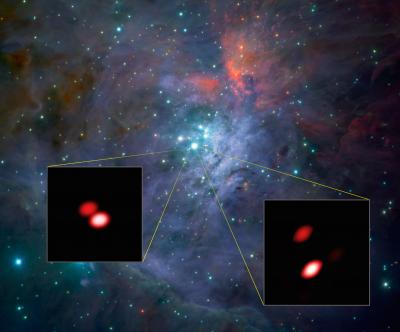

| Online: | |
| Visits: | |
| Stories: |

| Story Views | |
| Now: | |
| Last Hour: | |
| Last 24 Hours: | |
| Total: | |
Black Hole Probes Sees It’s First Light
The GRAVITY instrument combines the light from multiple telescopes to form a virtual telescope up to 200 metres across, using a technique called interferometry. This enables the astronomers to detect much finer detail in astronomical objects than is possible with a single telescope.
As part of the first observations with the new GRAVITY instrument the team looked closely at the bright, young stars known as the Trapezium Cluster, located in the heart of the Orion star-forming region. Already, from these first data, GRAVITY made a discovery: one of the components of the cluster (Theta1 Orionis F) was found to be a double star for the first time. The brighter double star Theta1 Orionis C is also well seen.
The background image comes from the ISAAC instrument on ESO’s Very Large Telescope. The views of two of the stars from GRAVITY, shown as inserts, reveal far finer detail than could be detected with the NASA/ESA Hubble Space Telescope.

Credit: ESO/GRAVITY consortium/NASA/ESA/M. McCaughrean
A crucial milestone has now been reached: for the first time, the instrument successfully combined starlight from the four VLT Auxiliary Telescopes. It would be more accurate to call this step “first fringes” as the milestone was the first successful combination of light from the different telescopes so that the beams interfered and fringes were formed and recorded.
As part of the first observations the team looked closely at the bright, young stars known as the Trapezium Cluster , located in the heart of the Orion star-forming region. Already, from these first commissioning data, GRAVITY made a small discovery: one of the components of the cluster was found to be a double star [3].
The key to this success was to stabilise the virtual telescope for long enough, using the light of a reference star, so that a deep exposure on a second, much fainter object becomes feasible. Furthermore, the astronomers also succeeded in stabilising the light from four telescopes simultaneously — a feat not achieved before. The newly discovered double star is Theta1 Orionis F, and the observations were made using the nearby brighter star Theta1 Orionis C as the reference.
GRAVITY can measure the positions of astronomical objects on the finest scales and can also perform interferometric imaging and spectroscopy. GRAVITY aims to measure the positions of objects on scales of order ten microarcseconds, and perform imaging with four milliarcsecond resolution. If there were buildings on the moon, GRAVITY would be able to spot them. Such extremely high resolution imaging has many applications, but the main focus in the future will be studying the environments around black holes.
So far, GRAVITY has been tested with the four 1.8-metre Auxiliary Telescopes. The first observations using GRAVITY with the four 8-metre VLT Unit Telescopes are planned for later in 2016.
Source:


